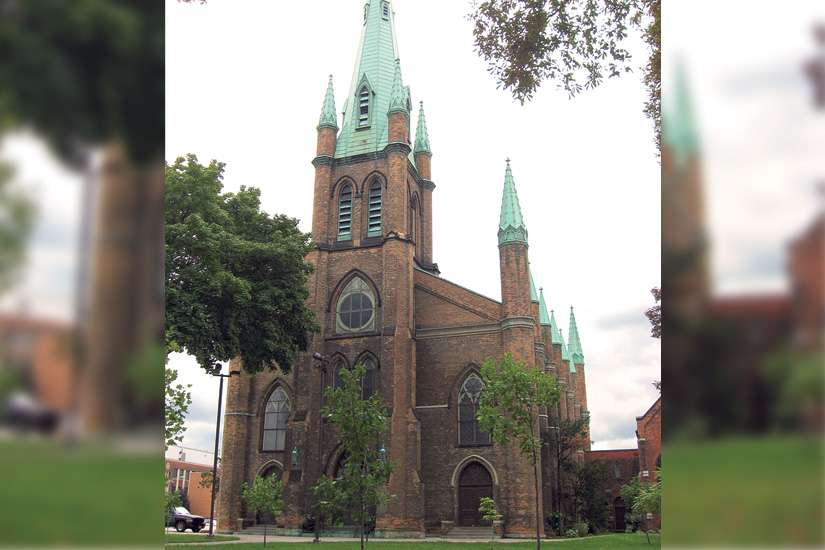Bishop Ronald Fabbro said the diocese is committed to see the almost 169-year-old church, a local religious and historic icon with community roots dating back to the 1720s, continue to operate. The problem has been acquiring sufficient funds to pay for the estimated $10 million to undertake the badly needed repairs.
The aged church needs significant rehabilitation including exterior wall reinforcement, masonry, roof work and upgrades to the electrical and mechanical systems.
Assumption is the oldest continuing parish in Ontario, dating from an original Jesuit mission for the local Huron and Ouendot First Nations in 1728. The current church was completed in 1845 and served as the cathedral for the Diocese of London from 1859 to 1869.
The closure, originally announced in late August, has distressed parishioners, particularly, they say, when there is a solid offer by an anonymous donor to pay for the restoration. But that offer did not come in until after the announcement was made to close the church, said Kim Spirou, a member of a committee that was raising funds. However, she said, “it was in the works and we communicated that to the diocese.”
Spirou says the money comes from a wealthy businessman “and it is a secured guaranteed line of credit for $10 million for the purpose of restoring Assumption Church. It’s in the donor’s bank. The donor’s bank has a guaranteed letter that the amount of money is there.”
Spirou said all this information “has been sent to the bishop.”
But Fabbro said the diocese needs time and is “doing our due diligence” on the offer.
“We said in our communication that given the fact that it’s one donor of $10 million and that there were complexities to it that we would not foresee having an answer until after the new year,” he said.
The large donation follows a similar one by a single individual that was rejected by the diocese. Fabbro said the earlier offer by another Windsor-area businessman for about $3 million “wouldn’t have been sufficient at all,” he said.
But Spirou, whose committee was formed after a high-level professional fundraising effort collapsed in 2012 when the diocese fired the private fundraising firm Philanthropic Management Consultants Inc., said the $3 million was matched by other funds to bring the total to $7 million, which was the “magic number” to get restoration started.
(The diocese had fired the philanthropy company after an audit showed only about $500,000 of $2.6 million in donations had gone towards the church.)
Then, she said, “there was a sudden change of heart” and the diocese decided not to accept the donor’s money. That decision came after the donor, Al Quesnel, president of The Athletic Club of fitness centres across Ontario, was charged last January with various weapons offences. Quesnel is a well-known philanthropist and has long had an interest in seeing the church preserved.
Meanwhile, the diocese has now closed the church because the bishop said it would be easier to preserve it this way, at least for the immediate future.
“My understanding is that it has been deteriorating,” Fabbro said. “The image we’ve used is it’s on life support. And our intention would be if we’re not using it that we would be able to preserve it, which we are not able to do if people are constantly using it.”
Structural engineers have told the diocese this is best done by maintaining the building at a constant temperature, which would be especially difficult to do during the winter months when people would be regularly using it.
Spirou accused the diocese of a “rush” to closure when there are no immediate problems with the building’s structure.
“The church is perfectly safe, we got through last winter fine, the heating system held up during the polar vortex, there’s no safety concerns that at least the parish is aware of,” she said.
And Kyle Vermette, a parishioner and theology student who recently created a Facebook page, Our Lady of Assumption: Operation Basilica, with more than 1,200 Likes, said the bishop is overly concerned about the strength of the roof. He said local architects “firmly don’t agree with that.”
Diocese spokesman Mark Adkinson has said the work is intricate and not always visible to the eye, and requires considerable expertise.
But Spirou thinks the diocese is no longer interested in keeping the church open.
“I feel there’s been some change of heart in terms of what they see as the future of Assumption,” she said.
Vermette is more optimistic. He said he was originally thinking of bringing a canon law challenge against the diocese, perhaps all the way to the Vatican, but put it aside “because of the change in tone of the diocese.”
He said the diocese originally appeared to want to close the church permanently “with no real explanation” but now has “a view that says we’re closing it to preserve it.”
Fabbro was in Windsor the Nov. 1-2 weekend to say all four weekend Masses at Assumption, and assured parishioners this was not “the final closure” of the church.
Ironically, a nearby church that was closed to worship two years ago, Holy Name of Mary, will now reopen and be the new home for Assumption churchgoers, as the parish itself continues to exist.
Assumption’s Rosary Chapel and Rosary Hall, part of the historic church complex, will continue to be used.
(Stang is a freelance writer in Windsor, Ont.)


